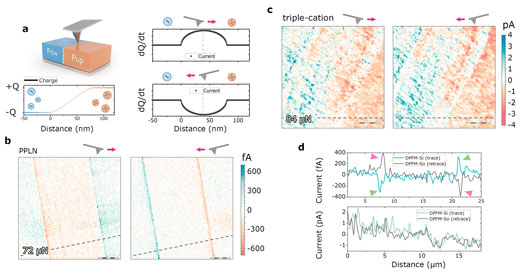| Jul 17, 2019 | |
Lead halide perovskites are not ferroelectric - so why are they so good for solar cells?(Nanowerk News) In a solar cell, when the sunlight impacts the material, a charge is generated. Specifically, this charge corresponds to an electron-hole pair, where an electron is excited to the conduction band, leaving a hole in the valence band. For the cells to be efficient, this pair of charges has to be separated and extracted as efficiently as possible (electron and hole must be directed to opposite electrodes to be captured) to generate an electric current. |
|
| This is where ferroelectricity comes into play: this property would generate a built-in electric field in the material that could assist charge separation. | |
| In the particular case of lead halide perovskites, ferroelectricity could help to understand why they work so well as active material in solar cells, and in fact, that was a plausible explanation so far. | |
| However, the study published in Energy & Environmental Science ("Ferroelectricity-free lead halide perovskites") by researchers from the Institute of Materials Science of Barcelona (ICMAB-CSIC) and the Helmholtz-Zentrum Berlin für Materialien und Energie (Germany) demonstrate, for the first time, that the fact that these materials are optimal for solar cells is not due to ferroelectricity. | |
| "This work is very interesting for understanding why these cells are so efficient," says Andrés Gómez, researcher at the ICMAB-CSIC and first author of the article. We will have to keep looking for the final answer. | |
 |
|
| Scan direction dependence of the DPFM signals. (a) Scheme of the DPFM measurement of a ferroelectric sample (top left panel), with an antiparallel domain configuration, in which “Pdw” stands for “polarisation down” and “Pup” for “polarisation up”. Upon application of a suitable mechanical load, a negative charge is built up by the piezoelectric effect on the left side while a positive charge is built up at the right side (bottom left panel). The signal recorded, that is the current, is the derivative of the charge and it reverses its sign when the tip crosses different domains, depending upon the scan direction: the tip going from left to right (top right panel) and from right to left (bottom right panel). (b) DPFM images obtained for periodically poled lithium niobate (PPLN) with an antiparallel domain configuration. Scale bar: 5 µm. For PPLN, the current sign is reversed as the scan direction changes, exactly as expected for a ferroelectric domain structure. (c) DPFM images of the CsFAMA perovskite scanned under similar conditions to those of PPLN. Scale bar: 5 µm. The CsFAMA perovskite does not show a sign reversal of the DPFM signal, but rather the images for the two scan directions (left and right panels) are quite similar, which resemble typical current-sensing AFM mapping. (d) Random profiles extracted from PPLN (top panel) and the CsFAMA perovskite (bottom panel). (click on image to enlarge) | |
The secret: the new technique used |
|
| The technique used to elucidate the non-ferroelectricity of lead halide perovskites is the DPFM (direct piezoelectric force microscopy) technique. A patent application describing the characterization technique was filed in 2017 by ICMAB-CSIC researchers. | |
| "Until now there was only one advanced mode of atomic force microscopy (AFM) called piezoresponse force microscopy (PFM) to study the ferroelectricity of these samples. However, this mode has caused a lot of controversy, as it is not reliable enough to distinguish between a ferroelectric material and one which is not. Although it is possible to measure ferroelectricity with PFM, other effects can give a false signal, obtaining erroneous results", explains Gómez. | |
| However, the DPFM technique, introduced in 2017 at the ICMAB-CSIC, complementary to PFM, measures the piezoelectric effect in a direct way and allows to clearly discern if a sample is ferroelectric or not. The technique does not produce spurious signals, since it excludes many measuring artefacts because via the piezoelectric effect a mechanical energy is directly converted into electrical energy in a strictly proportional way. | |
| This fact is fundamental to be able to examine the existence of ferroelectricity in lead halide perovskites, an issue that has been under debate for several years. | |
| For this study, polycrystalline samples of lead halide perovskites and samples of other materials with known ferroelectricity used as control were analyzed, and experiments were conducted with perovskites with different properties (grain size, layer thickness, different substrates, different textures...) using PFM and DPFM, and even EFM (electrostatic force microscopy). | |
| This is the first time that the DPFM technique is used in lead halide perovskite solar cells. "No other research group has been able, with nanometer-scale resolution, to elucidate whether these cells are really ferroelectric or not," says Gómez. Now we know. |
| Source: ICMAB | |
|
Subscribe to a free copy of one of our daily Nanowerk Newsletter Email Digests with a compilation of all of the day's news. |
